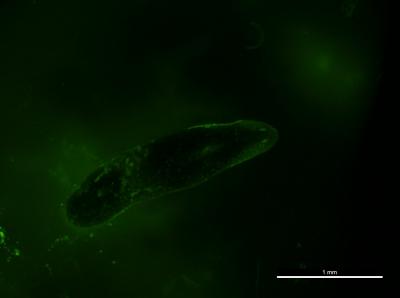
Credit: University of Reading, 2020
Tests for skin treatments could be screened using flatworms rather than other animals such as rabbits, according to new research.
A team at the University of Reading and Newcastle University have found that planaria, a type of flatworm, can be used as a reliable alternative for testing topical skin products used to treat human tissues such as the eyes, nose or vagina to ensure that they are not harmful.
The paper, published in Toxicology in Vitro, shows how the use of a fluorescent dye mixed with a potential skin product is absorbed through the outer layers of skin in the planaria.
The tests are cheaper and more ethical than existing animal tests, because planaria are readily available and easily cultured in a laboratory – and don’t experience suffering. While other tests are carried out on human skin cells in a petri dish, the new screening method would provide a more accurate test of how the potential skin product would interact with living tissue.
Professor Vitaliy Khutoryanskiy, a Professor of Formulation Science at the University of Reading said:
“Developing more ethical alternatives to tests that others do on rabbits, known as the Draize test, has been a major challenge, especially in relation to evaluating products for sensitive human tissue. Our tests with flatworms show that there are potential ways to screen skin irritants in a more ethically responsible way.
“While the vast majority of cosmetic skin products are no longer tested on animals, it remains critical that new developments for clinical treatments are tested robustly and we hope that we can find solutions that consign the Draize test to history. We also hope to continue planaria research and develop further tests for probe irritation potential of chemicals to other human tissues.”
A series of tests with the flatworms looked at whether they can be used to screen for products that are irritants to human skin. Two of the methods, which involved observing the movement of the worms when exposed to known irritants and measuring acute toxicity were not useful.
However, there was a positive result in tests which used the common fluorescent dye alongside short-term and low concentration exposure to various chemicals. The planaria which were exposed to known human skin irritants had significant levels of the fluorescent dye under their skin.
About Planaria:
Planaria are a freshwater-living flatworms which are already widely used in scientific research. They are advanced invertebrates with a primitive brain and share similar features with the vertebrate nervous system found in animals including mammals, examples of the ways that planaria are used include testing the neurotoxicity of potentially hazardous substances. Planaria have a simple but well-characterised epidermal membrane similar to skin that acts as the first point of contact between the worm and a foreign substance.
###
Media Contact
Tim Mayo
[email protected]
Related Journal Article
http://dx.




